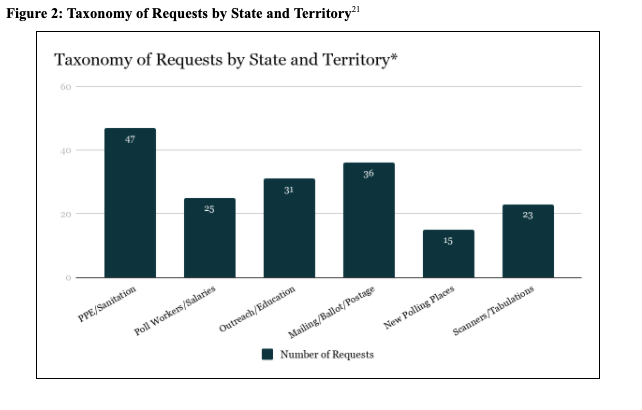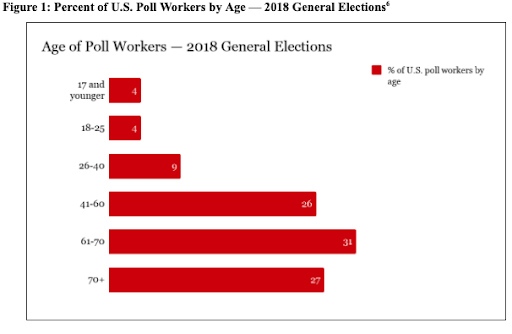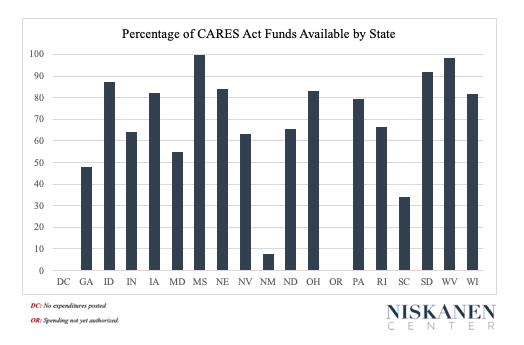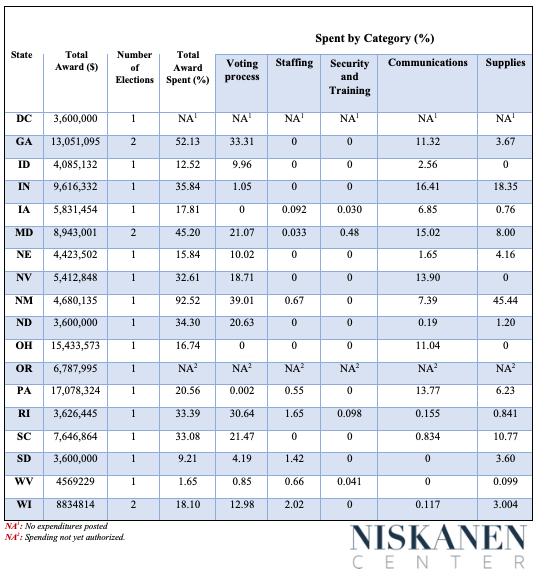THREAD: There are 100 days until #Election2020. Ensuring voters will have an array of safe options to #vote will require additional funding for states to conduct secure and inclusive elections. This is the last opportunity we have before the November elections. 1/
Niskanen was an early proponent of bipartisan support for ensuring access to more varied voting modalities. In March, @RuleandRuin highlighted the partisan divisions despite calls from Republican and Democratic state leaders for more funding. 2/ https://www.niskanencenter.org/the-u-s-must-prepare-to-allow-all-citizens-to-vote-by-mail-in-upcoming-elections/
Along with our coalition partners, we asked Congress to help fund elections. @IssueOneReform, @DemocracyFund, @RSI, @StandUpAmerica, @protctdemocracy, @ProjectLincoln, and many others published incredible analysis. From @BrennanCenter: https://www.brennancenter.org/issues/defend-our-elections/election-security. 3/
In April, @NiskanenCenter’s @kdpindc, @RuleandRuin, and @khilldavis discussed the $400 million dedicated to election security grants to the states as part of the historic $2 trillion coronavirus aid package passed this spring. 4/ https://www.niskanencenter.org/niskanen-center-covid-19-briefing-election-security-during-a-pandemic/
This investment was critical for states to conduct primaries throughout the spring and summer this year. But election experts estimate that states will need significant additional funding to ensure that November elections are safe and secure. 5/ https://www.niskanencenter.org/press-release-niskanen-applauds-phase-iii-election-security-grants-but-more-funding-is-necessary/
According to a recent report by @pewresearch, over 67% of adults believe that the coronavirus will significantly disrupt Americans’ ability to vote in November—that includes 50% of Republicans and 80% of Democrats. #Election2020 6/ https://www.pewresearch.org/topics/2020-election/
Of the 53% of poll worker respondents who reported age date to the 2017 Election Administration and Voting Survey (EAVS), 24% were 71 and older; 32% were between the ages of 61 and 70. 7/ https://www.eac.gov/documents/2017/11/15/eavs-deep-dive-poll-workers-and-polling-places
Here are some of the challenges for states in hosting primaries and elections, and how they’re using the funds they received in March 2020, according to @MLaCorte_. #Election2020 8/ https://www.niskanencenter.org/47-states-and-territories-requested-ppe-from-the-federal-government-to-protect-their-elections/
The 2020 primary elections have demonstrated that the states are not prepared to hold elections during a pandemic. 9/
Following the primary elections in Wisconsin at the height of the pandemic in that state, the Milwaukee Health Department estimated that 52 voters and two poll workers were infected by COVID-19 while voting in person in Milwaukee County. 10/ https://www.jsonline.com/story/news/politics/2020/05/06/coronavirus-milwaukee-26-may-have-been-infected-during-voting/5177021002/
Voters also encountered poll closures, poll worker shortages, poll workers with inadequate training, malfunctioning machines, and long lines. #Election2020 #ElectionIntegrity 11/ https://www.nytimes.com/2020/06/10/us/politics/georgia-primary-election-voting.html
Many more people likely contracted the illness while performing their civic duty, and it could prove fatal for an untold number of them. And many more voters, particularly voters of color, feel unsafe exercising their right to vote. 12/
Mass disenfranchisement of voters on this scale may put the integrity of American democracy at risk. No American should have to choose between staying safe and exercising a Constitutional right. #Election2020 #COVID19 13/
More bipartisan support for #ElectionIntegrity exists than ever before. In May, Niskanen’s @kdpindc called for the end of partisanship on election processes, highlighting the threat to Republicans and Democrats alike if no additional action is taken. 14/ https://www.niskanencenter.org/stop-making-elections-processes-partisan-theyre-not/
The largest share of the electorate that supported Trump in 2016 were voters aged 50-64 (29% of the overall electorate) and voters over 65 (27% of the overall electorate). This population is at a very high risk for severe illness from COVID-19. 15/ https://www.people-press.org/2018/08/09/an-examination-of-the-2016-electorate-based-on-validated-voters/
In April, US Rep @RodneyDavis (R- #IL13) supported calls from Paul Pate, the President of the National Association of Secretaries of State, calling for important reforms to the initial grants and calling for more support. 16/ https://republicans-cha.house.gov/sites/republicans.cha.house.gov/files/documents/Letter%20to%20Chairperson%20Lofgren%20from%20Ranking%20Member%3B%20NASS_0.pdf
In June, a group of right-of-center organizations—including the Niskanen Center—requested additional investments to ensure that Americans can safely vote. 17/ https://www.rstreet.org/wp-content/uploads/2020/06/Final-Abentee-Voting-Federal-Letter.pdf
More recently, a group of Senate Democrats voiced their support for providing additional PPE and sanitizing equipment ahead of general elections, citing @NiskanenCenter research. 18/ https://www.menendez.senate.gov/imo/media/doc/2020.07.21%20Letter%20to%20VP%20Pence%20and%20Administrator%20Gaynor.pdf
There is little time to implement nationwide absentee voting, but there is still time to secure additional PPE and make practical changes to voting processes. 19/
What do states need? Funding! Several states are near or below 50% of total remaining funds for the general election, including GA, KY, MD, NM, NY, & SC. 20/
For many states, the funding will help secure PPE and protect voting processes. According to @NiskanenCenter analysis, most states’ funding has been spent on securing voting processes, staffing, security and training, communications, and sanitary supplies. 21/
But in addition to funding, Phase 4 must do more. In a statement for a House hearing on election security in June, @NiskanenCenter called for several additional changes. 22/ https://www.niskanencenter.org/statement-for-the-record-before-the-house-voting-rights-and-election-administration/
1—Waive the 20% state funding match for disbursement of election support funding from CARES Act in exigent circumstances and provide additional election assistance funding. 23/
Per the CARES Act, states must match 20% of the total amount awarded and incur costs to meet that amount by March 27, 2022. If states meet the match requirements, they must deposit nearly $80 million ($79,519,998.00) to utilize the federal grants. 24/
For several states, this requirement is problematic. Maine is struggling to claim the $3,299,827 offered by the federal government in the CARES Act, because it can’t appropriate the $659,965 owed for its matching portion, as the legislature is currently adjourned… 25/
...About 15 state legislatures have already adjourned for the year, which means that unless they can call a special session to order before the December 31, 2020 expiration date, they will not reconvene until early 2021 and cannot appropriate matching funds…. 26/
...Plummeting state revenue is an increasing obstacle to securing matching funding, even if a state legislature is in session. Accessing and appropriating the matching 20% to receive federal funds is exacerbated by the states’ respective needs. 27/
State and county leaders continue to express concern about mounting election costs. Officials in Ohio have suggested that even after receiving $12 million from the CARES Act, they need an additional $66-86 million to cover primary and November election associated costs. 28/
2—Provide additional funding for PPE and crackdown on COVID-19 procurement scams. On April 2, the National Association of Secretaries of State (NASS) underscored ongoing concerns about financial hardship due to the difficulty procuring quality PPE. 29/ https://republicans-cha.house.gov/sites/republicans.cha.house.gov/files/documents/4.2.20%20NASS%20CARES%20Funding%20Letter%20to%20House%20Admin%5B4%5D.pdf
According to a recent report by @propublica, the scarcity of masks and other PPE has created an unregulated and chaotic market that pits states against one another in bidding wars—which also inevitably drives up costs. 30/ https://www.healthleadersmedia.com/welcome-ad?toURL=/innovation/secret-absurd-world-coronavirus-mask-traders-and-middlemen-trying-get-rich-government
Both federal and state contracts with untested companies have resulted in payments “as much as 6X the manufacturer’s list price.” This exacerbates the growing state/county deficits and creates a significant opportunity for fraud. 31/
3—Delay the 20-day reporting requirement for states and extend the obligation date. For many states, these requirements are unnecessarily arduous, and the short designated timeframe is a recipe for incomplete analysis or noncompliance. 32/
Here’s why: Elections don’t end on Election Day. Processes like signature verification, tabulating votes, certifying and auditing the election, etc. can take election officials days, weeks, and sometimes months to complete. 33/
Equally troublesome is the requirement that states obligate or spend all CARES Act funding by December 31, 2020. Again, as highlighted by NASS, this deadline is complicated by the adjournment of legislatures and other appropriations restraints. 34/ https://republicans-cha.house.gov/sites/republicans.cha.house.gov/files/documents/4.2.20%20NASS%20CARES%20Funding%20Letter%20to%20House%20Admin%5B4%5D.pdf
Extending the reporting deadline to June 1, 2021, and allowing states to reimburse any costs incurred in the administration of the elections through March 1, 2021 will help ensure comprehensive reporting on total expenditures. 35/
4—Create a new program that funds university and college students to work to prepare for and administer elections. 36/ https://www.niskanencenter.org/coeds-against-covid-hiring-college-students-for-the-2020-elections/
One of the most urgent threats to a safe election is poll workers' availability to work leading up to and on election day. Given the average age of poll workers, most are high-risk for severe complications resulting from contracting COVID-19. 37/ https://www.niskanencenter.org/coeds-against-covid-hiring-college-students-for-the-2020-elections/
College-age students are much less likely to experience severe complications from COVID-19. Relative risk of dying from COVID-19 for individuals ages 15-24 is 0.55 (deaths per 100,000 population). The risk jumps to 2.13 for individuals of ages 65-74. 38/ https://www.bloomberg.com/opinion/articles/2020-05-07/comparing-coronavirus-deaths-by-age-with-flu-driving-fatalities
In addition to providing quality protective gear for all workers, we should set up a grant program that incentivizes college-age individuals and students to participate in election administration and to work polls across America on election day. 39/
#COVID19 presents a huge challenge to the 16.9 million students enrolled in colleges/universities across America. Many students rely on campus work programs or temporary summer jobs to supplement the cost of future classes, having a car, loans, etc. https://fortune.com/2020/05/05/stimulus-checks-college-students-debt/ 40/
We don’t see a one-size-fits-all solution for every state. But we do see the need for responsive guidelines that address the risks associated with elections during a pandemic. We must provide election assistance to help states prepare for safe November elections now. 41/41

 Read on Twitter
Read on Twitter





